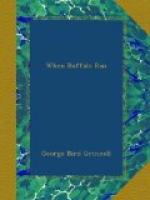As I walked behind my uncle, following him over the prairie, I tried to watch him, and to imitate everything that he did. If he stopped, I stopped; if he bent down his head, and went stooping for a little way, I also stooped, and followed him; when he got down to creep, I, too, crept, so as to be out of sight.
That day, as the sun fell toward the west, my uncle went down to the river, and looked along the bank and the mud-bars, trying to learn whether any animals had been to the water; and when he saw tracks he pointed them out to me. “This,” he said, “is the track of a deer. You see that it has been going slowly. It is feeding, because it does not go straight ahead, but goes now in one direction, and then in another, and back a little, not seeming to have any purpose in its wandering about, and here,” showing me a place where a plant had been bitten off, “is where it was eating. If we follow along, soon we will see its tracks in the mud by the river.” It was as he had said, and soon, in a little sand-bar, we saw the place where the animal had stopped. “You see,” he said, “this was a big deer; here are his tracks; here he stopped at the edge of the water to drink; and then he went on across the river, for there are no tracks leading back to the bank. You will notice that he was walking; he was not frightened; he did not see nor smell any enemies.”
Further up the river, on a sand-bar, he showed me the tracks of antelope, where the old ones had walked along quietly, and other smaller tracks, where the sand had been thrown up; and these marks, he said, were made by the little kids, which were playing and running.
“Notice carefully,” he said, “the tracks that you see, so that you will remember them, and will know them again. The tracks made by the different animals are not all alike. The antelope’s hoof is sharp-pointed in front. Notice, too, that when his foot sinks in the mud there is no mark behind his footprint; while behind the footprint of a deer there are two marks, in soft ground, made by the little hoofs that the deer has on his foot.”




